The following is a guest blog post by Katie Workman, cookbook author and member of the No Kid Hungry Leadership Council.
This spring my family decamped to New Milford, Conn., where my son and I began volunteering at a local food pantry.
When the pandemic began, the staff at the pantry switched to a socially-distanced drive-thru arrangement. The cars move down a line of tables heaped with different offerings, which change from week to week. They let people select what they wanted and needed, as they did when the pantry was indoors, rather than be handed pre-bagged totes of food. Letting families choose not only preserved their dignity, it cut down on waste by preventing people from getting unwanted food.

But all of these things aren’t what makes the New Milford Social Serves Pantry so great.
What makes this pantry so great is Sarah, the head of the agency. And Diane and Kelli and Maria and Jess and Wanda and Donald, employees and volunteers. From day one it was clear that people weren’t just there for the food. They were there for warmth and concern and kindness and the fact that the people working at the pantry knew to save the gluten-free crackers for Peter*, that Amanda was going to be so excited that we had plums again, and that Sam was a pescatarian, so remember to put aside some salmon for him.
Every week there are specific moments that make me even more aware of the fragility of it all. There is the woman I recognize as a supermarket employee, driving through the line with her Stop & Shop nametag on her uniform, picking up food for her family before she heads to work to stock the shelves with groceries. There is the woman who tells us about her brain tumor and the surgery she is about to have. She doesn’t know what’s going to happen, and she asks for prayers as we load up her car with extra. Her son, sitting behind her, is heading into 8th grade, but she says she has to keep him home for sure, as she can’t risk bringing the virus into their home. There’s the lady whose mom died of COVID, and her son is afraid to go anywhere now, so she has to get home quickly because she doesn’t want to leave him alone for long.
Sometimes people don’t want to talk much – some are just there for the supplies, some have other first languages, and some may feel uncomfortable to be at a food pantry, perhaps for the first time in their lives.
The kids in the back seats of the cars range in age from infancy to teens. The teenagers are usually quiet – I imagine my own teenage boys in the back of the car, and offer a hello, a masked smile (I hope they can see the crinkling in the corner of my eyes), a wave, but leave them alone. Littler kids might be more engaged, shouting out their choice of cereal, excited to see baby watermelons. Each and every one of these kids represents one of the numbers we all find so numbing and impossible to absorb. Each of these children is one of the children who are food insecure or hungry. Each person behind the steering wheel of the car is the mother or father or guardian of one of those kids who aren’t getting enough to eat without help.
We hand out fresh produce and canned potatoes, we hand out macaroni and cheese and brown rice, we hand out oatmeal and sugary cereal, we hand out pork chops and tinned meat. Some of the food comes from nearby farms, some come from the CT Food Bank, some come from individual donations, and some come from neighborhood supermarkets or manufacturers. During the summer, the array and amount of produce is heartening. Fort Hill Farm just up the road seems to be enjoying a bumper crop this year, and they are very big-hearted. But we are all aware that it’s easy to have the produce stacked high during the summer months, and summer is ending soon.
Most of the clients return week after week, but there are always a couple of first-timers, and in some cases, it’s clear that this is their first time visiting a food pantry. That new circumstances have arisen that necessitate a need for additional food for their households. And in a bunch of cases, these guests are not strangers to the people working there. Sarah’s kids go to school with some of their kids. Diane, a retired pediatrician, was the doctor to some of the families. Several people come on foot and last week one of the driving regulars gave a ride home to another of the ambulatory regulars. And it’s become clear that two of the driving regulars who carpool are now a couple, a COVID food pantry romance taken root.
Mary, one of the favorites, always comes towards the end because she wants to chat with all of us, and doesn’t want to hold up the line. Her thank-yous are always genuine and profuse. It’s frankly an uncomfortable thing to be thanked for something so necessary. It’s also a weird thing to be thanked for doing something that makes you feel good and useful. And it’s unfortunate to have to be thanked for making sure everyone’s basic right to enough food is being met.
I am hoping with all of my being that the federal government prioritizes the feeding of Americans, children in particular, at the highest level. But no matter what happens this fall, we must collectively address feeding hungry people in this country with urgency right now, and for the foreseeable future.
We hope for a day where food pantries are a thing of the past, but that is not today. In fact, today the obligation of feeding our neighbors rests on a combination of meeting the immediate need right this very moment through whatever means necessary and working towards changing policy so that in the future the world is a more equitable place where parents do not have to worry about getting dinner on the table, buying groceries or paying their rent or electric bills.
In my work as a hunger activist, I’ve taken on a lot of roles. I sit on boards and leadership councils, I participate in committees, I’ve chaired events, I’ve lobbied and I donate money. But far and away the piece of hunger relief volunteerism that means the most to me is the hands-on part – while I know it doesn’t move the needle at the scale that lobbying on the Hill or hosting a fundraiser work does, it’s the part that connects the dots for me. Working to actually get food to the people who need it makes me understand the need in the most human way, far more tangible than all of the sobering statistics: the pounds of food moved, the cost of delivering each school lunch, the millions of children not getting enough to eat.
So, what can we do, as individuals?
We must urge our representatives to step up, speak out, and be on the right side of this fight. And let me be clear: This is not a partisan issue—hungry kids don’t see red or blue, they see only the stress on their parents’ faces. All they feel is the emptiness in their bellies and the enervation that comes with being hungry.
In the past few days, after an enormous amount of waiting and lobbying and holding our collective breaths, we found out that the USDA just extended child nutrition waivers so that kids can have enough to eat as the school year begins, and the weather gets colder. But these benefits are only extended through December right now – and we certainly know the need will extend beyond that time.
Contact your legislators, and let them know there is no priority more important than feeding hungry kids.
And while it isn’t safe for everyone to volunteer, you might seek out opportunities in your town or region. In a time of such uncertainty, such loss of control, it truly feels good to do something physical to help.
It is unconscionable to let one child, much less 14 million children, go hungry. Please join me in fighting for fairness.
*All names have been changed to protect the privacy of the individuals.


